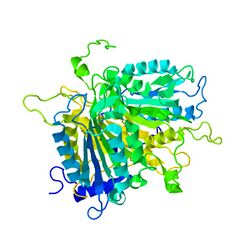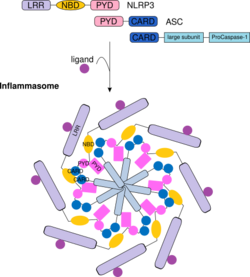Biology:Caspase 1
 Generic protein structure example |

Caspase-1/Interleukin-1 converting enzyme (ICE) is an evolutionarily conserved enzyme that proteolytically cleaves other proteins, such as the precursors of the inflammatory cytokines interleukin 1β and interleukin 18 as well as the pyroptosis inducer Gasdermin D, into active mature peptides.[1][2][3] It plays a central role in cell immunity as an inflammatory response initiator. Once activated through formation of an inflammasome complex, it initiates a proinflammatory response through the cleavage and thus activation of the two inflammatory cytokines, interleukin 1β (IL-1β) and interleukin 18 (IL-18) as well as pyroptosis, a programmed lytic cell death pathway, through cleavage of Gasdermin D.[4] The two inflammatory cytokines activated by Caspase-1 are excreted from the cell to further induce the inflammatory response in neighboring cells.[5]
Cellular expression
Caspase-1 is evolutionarily conserved in many eukaryotes of the Kingdom Animalia. Due to its role in the inflammatory immune response, it is highly expressed in the immune organs such as the liver, kidney, spleen, and blood (neutrophils).[6][7] Following infection, the inflammatory response increases expression of Caspase-1, by a positive feedback mechanism that amplifies the response.[7]
Structure
Caspase-1 is produced as a zymogen that can then be cleaved into 20 kDa (p20) and 10 kDa (p10) subunits that become part of the active enzyme. Active Caspase 1 contains two heterodimers of p20 and p10. It contains a catalytic domain with an active site that spans both the p20 and p10 subunits,[8] as well as a noncatalytic Caspase Activation and Recruitment Domain (CARD) . It interacts with other CARD containing proteins such as Apoptosis-Associated Speck-like Protein Containing a CARD (ASC) and Nod-Like Receptor (NLR) Family CARD Domain-Containing Protein 4 (NLRC4) through CARD-CARD interactions in the formation of inflammasomes.[3][9]
Regulation


Activation

Caspase-1, normally in its physiologically inactive zymogen form, autoactivates when it is assembled into the filamentous inflammasome complex by autoproteolysis into the p10 and p20 subunits.[10][11] The inflammasome complex is a ring complex composed of trimers of a signal specific sensor protein such as those of the NLR family and the AIM-1 (Absent in Melanoma) like receptors, an adaptor protein such as ASC, and a caspase, in this case Caspase-1. In some cases, where the signaling proteins contain their own CARDs, like in NLRP1 and NLRC4, the CARD –CARD interaction is direct, meaning there is no adaptor protein in the complex. There are a variety of sensor and adaptor proteins, the various combinations of which confer the inflammasomes' responses to specific signals. This allows the cell to have varying degrees of inflammatory responses based on the severity of the danger signal received.[12][13]
Inhibition
CARD only proteins (COPs) as their name implies, are proteins that only contain the non-catalytic CARDs. Owing to the importance of CARD-CARD interactions in inflammasome formation, many COPs are known inhibitors of Caspase activation. For Caspase-1, genes for specific COPs—ICEBERG, COP1 (ICE/Pseudo-ICE), and INCA (Inhibitory Card)—are all found near its locus, and are thus thought to have emerged from gene duplication events and subsequent deletions of the catalytic domains. Though they all interact with the inflammasomes using CARD–CARD interactions, they differ in the way they carry out their inhibitory functions as well as in their effectiveness at doing so.[11][14][15]
For example, ICEBERG nucleates the formation of Caspase-1 filaments and is thus incorporated into the filaments, but lacks the ability to inhibit the activation of inflammasomes. Instead, it is thought to inhibit Caspase-1 activation by interfering with the interaction of Caspase-1 with other important CARD containing proteins.[11][14][15]
INCA, on the other hand, directly blocks inflammasome assembly by capping Caspase-1 CARD oligomers, thus blocking further polymerization into the inflammasome filaments.[14][15][16][9]
Similarly, some POPs (Pyrin only proteins) are also known to regulate Caspase-1 activation through inhibition of inflammasome activation by binding to and blocking PYD interactions, which also play a role in the formation of the inflammasomes, though the exact mechanisms are not yet well established.[15][17]
- Inhibitors
- Belnacasan (VX-765) [18]
- Pralnacasan (VX-740) [19]
Function
Proteolytic cleavage
Activated Caspase 1 proteolytically cleaves pro IL-1β and pro IL-18 into their active forms, IL-1β and IL-18. The active cytokines lead to a downstream inflammatory response. It also cleaves Gasdermin D into its active form, which leads to pyroptosis.[9]
Inflammatory response
Once matured, the cytokines initiate downstream signaling events to induce a proinflammatory response as well as to activate the expression of antiviral genes. The speed, specificity and types of response are dependent on the signal received as well as the sensor protein that received it. Signals that can be received by the inflammasomes include viral double stranded RNA, urea, free radicals, and other signals associated with cellular danger, even byproducts of other immune response pathways.[20]
The mature cytokines themselves do not contain the necessary sorting sequences to enter the ER-Golgi secretory pathway, and thus are not excreted from the cell by conventional methods. However, it is theorized that the release of these proinflammatory cytokines is not reliant on cellular rupture via pyroptosis, and is in fact, an active process. There exists evidence both for and against this hypothesis. The fact that for many cell types, the cytokines are secreted despite them showing absolutely no signs of pyroptosis, supports this hypothesis.[13][21] However, some experiments show that Gasdermin D nonfunctional mutants still had normal cleavage of the cytokines but lacked the ability to secrete them, indicating pyroptosis may in fact be necessary for secretion in some way.[22]
Pyroptosis response
Following the inflammatory response, an activated Caspase-1 can induce pyroptosis, a lytic form of cell death, depending on the signal received as well as the specific inflammasome sensor domain protein that received it. Though pyroptosis may or may not be required for the full inflammatory response, the inflammatory response is fully required before pyroptosis can occur.[13] In order to induce pyroptosis, Caspase-1 cleaves Gasdermin D into fragments that form pores in the plasma membrane. As a result of osmotic pressure, these pores promote the influx of fluid, resulting in cell lysis and death.[23]
Other roles
Caspase-1 has also been shown to induce necrosis and may also function in various developmental stages. Studies of a similar protein in mice suggest a role in the pathogenesis of Huntington's disease. Alternative splicing of the gene results in five transcript variants encoding distinct isoforms.[24] Recent studies implicated caspase-1 in promoting CD4 T-cell death and inflammation by HIV, two signature events that fuel HIV disease progression to AIDS.[25][26][27] Caspase-1 activity has also been implicated in lysosome acidification following phagocytosis of bacteria[28] and immune complexes.[29]
See also
References
- ↑ "A novel heterodimeric cysteine protease is required for interleukin-1 beta processing in monocytes". Nature 356 (6372): 768–74. April 1992. doi:10.1038/356768a0. PMID 1574116. Bibcode: 1992Natur.356..768T.
- ↑ "Molecular cloning of the interleukin-1 beta converting enzyme". Science 256 (5053): 97–100. April 1992. doi:10.1126/science.1373520. PMID 1373520. Bibcode: 1992Sci...256...97C.
- ↑ 3.0 3.1 "Differential activation of the inflammasome by caspase-1 adaptors ASC and Ipaf". Nature 430 (6996): 213–8. July 2004. doi:10.1038/nature02664. PMID 15190255. Bibcode: 2004Natur.430..213M.
- ↑ "Gasdermin D pore structure reveals preferential release of mature interleukin-1". Nature 593 (7860): 607–611. April 2021. doi:10.1038/s41586-021-03478-3. PMID 33883744. Bibcode: 2021Natur.593..607X.
- ↑ "Pyroptotic cell death defends against intracellular pathogens". Immunological Reviews 265 (1): 130–42. May 2015. doi:10.1111/imr.12287. PMID 25879289.
- ↑ "Localization and functionality of the inflammasome in neutrophils". The Journal of Biological Chemistry 289 (8): 5320–9. February 2014. doi:10.1074/jbc.M113.505636. PMID 24398679.
- ↑ 7.0 7.1 "Multifunctional murrel caspase 1, 2, 3, 8 and 9: Conservation, uniqueness and their pathogen-induced expression pattern". Fish & Shellfish Immunology 49: 493–504. February 2016. doi:10.1016/j.fsi.2016.01.008. PMID 26777895.
- ↑ "Structure and mechanism of interleukin-1 beta converting enzyme". Nature 370 (6487): 270–5. July 1994. doi:10.1038/370270a0. PMID 8035875. Bibcode: 1994Natur.370..270W.
- ↑ 9.0 9.1 9.2 "Molecular basis of caspase-1 polymerization and its inhibition by a new capping mechanism". Nature Structural & Molecular Biology 23 (5): 416–25. May 2016. doi:10.1038/nsmb.3199. PMID 27043298.
- ↑ "Crystal structure of procaspase-1 zymogen domain reveals insight into inflammatory caspase autoactivation". The Journal of Biological Chemistry 284 (10): 6546–53. March 2009. doi:10.1074/jbc.M806121200. PMID 19117953.
- ↑ 11.0 11.1 11.2 "ICEBERG: a novel inhibitor of interleukin-1beta generation". Cell 103 (1): 99–111. September 2000. doi:10.1016/S0092-8674(00)00108-2. PMID 11051551.
- ↑ "Imbalanced production of IL-18 and its antagonist in human diseases, and its implications for HIV-1 infection". Cytokine. Cytokines in inflammation, aging, cancer and obesity 82: 38–51. June 2016. doi:10.1016/j.cyto.2016.01.006. PMID 26898120.
- ↑ 13.0 13.1 13.2 "The intersection of cell death and inflammasome activation". Cellular and Molecular Life Sciences 73 (11–12): 2349–67. June 2016. doi:10.1007/s00018-016-2205-2. PMID 27066895.
- ↑ 14.0 14.1 14.2 "Regulation of IL-1beta generation by Pseudo-ICE and ICEBERG, two dominant negative caspase recruitment domain proteins". Cell Death and Differentiation 8 (6): 649–57. June 2001. doi:10.1038/sj.cdd.4400881. PMID 11536016.
- ↑ 15.0 15.1 15.2 15.3 "Pyrin- and CARD-only Proteins as Regulators of NLR Functions". Frontiers in Immunology 4: 275. September 2013. doi:10.3389/fimmu.2013.00275. PMID 24062743.
- ↑ "INCA, a novel human caspase recruitment domain protein that inhibits interleukin-1beta generation". The Journal of Biological Chemistry 279 (50): 51729–38. December 2004. doi:10.1074/jbc.M407891200. PMID 15383541.
- ↑ "A Shope Fibroma virus PYRIN-only protein modulates the host immune response". Virus Genes 35 (3): 685–94. December 2007. doi:10.1007/s11262-007-0141-9. PMID 17676277.
- ↑ "Caspase-1 inhibition alleviates cognitive impairment and neuropathology in an Alzheimer's disease mouse model". Nature Communications 9 (1): 3916. September 2018. doi:10.1038/s41467-018-06449-x. PMID 30254377. Bibcode: 2018NatCo...9.3916F.
- ↑ "A highly potent and selective caspase 1 inhibitor that utilizes a key 3-cyanopropanoic acid moiety". ChemMedChem 5 (5): 730–8. May 2010. doi:10.1002/cmdc.200900531. PMID 20229566.
- ↑ "IL-1 receptor/Toll-like receptor signaling in infection, inflammation, stress and neurodegeneration couples hyperexcitability and seizures". Brain, Behavior, and Immunity 25 (7): 1281–9. October 2011. doi:10.1016/j.bbi.2011.03.018. PMID 21473909.
- ↑ "Interleukin-1β Processing Is Dependent on a Calcium-mediated Interaction with Calmodulin". The Journal of Biological Chemistry 290 (52): 31151–61. December 2015. doi:10.1074/jbc.M115.680694. PMID 26559977.
- ↑ "Gasdermin D is an executor of pyroptosis and required for interleukin-1β secretion". Cell Research 25 (12): 1285–98. December 2015. doi:10.1038/cr.2015.139. PMID 26611636.
- ↑ "Pyroptosis: Gasdermin-Mediated Programmed Necrotic Cell Death" (in English). Trends in Biochemical Sciences 42 (4): 245–254. April 2017. doi:10.1016/j.tibs.2016.10.004. PMID 27932073.
- ↑ "Entrez Gene: CASP1 caspase 1, apoptosis-related cysteine peptidase (interleukin 1, beta, convertase)". https://www.ncbi.nlm.nih.gov/sites/entrez?Db=gene&Cmd=ShowDetailView&TermToSearch=834.
- ↑ "Cell death by pyroptosis drives CD4 T-cell depletion in HIV-1 infection". Nature 505 (7484): 509–14. January 2014. doi:10.1038/nature12940. PMID 24356306. Bibcode: 2014Natur.505..509D.
- ↑ "IFI16 DNA sensor is required for death of lymphoid CD4 T cells abortively infected with HIV". Science 343 (6169): 428–32. January 2014. doi:10.1126/science.1243640. PMID 24356113. Bibcode: 2014Sci...343..428M.
- ↑ "NLRP3 inflammasome induces CD4+ T cell loss in chronically HIV-1-infected patients". The Journal of Clinical Investigation 131 (6). March 2021. doi:10.1172/JCI138861. PMID 33720048.
- ↑ "Activation of caspase-1 by the NLRP3 inflammasome regulates the NADPH oxidase NOX2 to control phagosome function". Nature Immunology 14 (6): 543–53. June 2013. doi:10.1038/ni.2595. PMID 23644505.
- ↑ "mTORC2 Activity Disrupts Lysosome Acidification in Systemic Lupus Erythematosus by Impairing Caspase-1 Cleavage of Rab39a". Journal of Immunology 201 (2): 371–382. July 2018. doi:10.4049/jimmunol.1701712. PMID 29866702.
External links
 |
![1bmq: CRYSTAL STRUCTURE OF THE COMPLEX OF INTERLEUKIN-1BETA CONVERTING ENZYME (ICE) WITH A PEPTIDE BASED INHIBITOR, (3S )-N-METHANESULFONYL-3-({1-[N-(2-NAPHTOYL)-L-VALYL]-L-PROLYL }AMINO)-4-OXOBUTANAMIDE](/wiki/images/thumb/e/e3/PDB_1bmq_EBI.jpg/250px-PDB_1bmq_EBI.jpg)



![1rwm: Crystal structure of human caspase-1 in complex with 4-oxo-3-[2-(5-{[4-(quinoxalin-2-ylamino)-benzoylamino]-methyl}-thiophen-2-yl)-acetylamino]-pentanoic acid](/wiki/images/thumb/4/4f/PDB_1rwm_EBI.jpg/250px-PDB_1rwm_EBI.jpg)
![1rwn: Crystal structure of human caspase-1 in complex with 3-{2-ethyl-6-[4-(quinoxalin-2-ylamino)-benzoylamino]-hexanoylamino}-4-oxo-butyric acid](/wiki/images/thumb/a/a1/PDB_1rwn_EBI.jpg/250px-PDB_1rwn_EBI.jpg)
![1rwo: Crystal structure of human caspase-1 in complex with 4-oxo-3-{6-[4-(quinoxalin-2-ylamino)-benzoylamino]-2-thiophen-2-yl-hexanoylamino}-pentanoic acid](/wiki/images/thumb/e/e2/PDB_1rwo_EBI.jpg/250px-PDB_1rwo_EBI.jpg)
![1rwp: Crystal structure of human caspase-1 in complex with 3-{6-[(8-hydroxy-quinoline-2-carbonyl)-amino]-2-thiophen-2-yl-hexanoylamino}-4-oxo-butyric acid](/wiki/images/thumb/2/2d/PDB_1rwp_EBI.jpg/250px-PDB_1rwp_EBI.jpg)
![1rwv: Crystal structure of human caspase-1 in complex with 5-[5-(1-carboxymethyl-2-oxo-propylcarbamoyl)-5-phenyl-pentylsulfamoyl]-2-hydroxy-benzoic acid](/wiki/images/thumb/7/70/PDB_1rwv_EBI.jpg/250px-PDB_1rwv_EBI.jpg)
![1rww: Crystal structure of human caspase-1 in complex with 4-oxo-3-[(6-{[4-(quinoxalin-2-ylamino)-benzoylamino]-methyl}-pyridine-3-carbonyl)-amino]-butyric acid](/wiki/images/thumb/8/8a/PDB_1rww_EBI.jpg/250px-PDB_1rww_EBI.jpg)
![1rwx: Crystal structure of human caspase-1 in complex with 4-oxo-3-{6-[4-(quinoxalin-2-yloxy)-benzoylamino]-2-thiophen-2-yl-hexanoylamino}-butyric acid](/wiki/images/thumb/b/ba/PDB_1rwx_EBI.jpg/250px-PDB_1rwx_EBI.jpg)



![2fqq: Crystal structure of human caspase-1 (Cys285->Ala, Cys362->Ala, Cys364->Ala, Cys397->Ala) in complex with 1-methyl-3-trifluoromethyl-1H-thieno[2,3-c]pyrazole-5-carboxylic acid (2-mercapto-ethyl)-amide](/wiki/images/thumb/4/4b/PDB_2fqq_EBI.png/250px-PDB_2fqq_EBI.png)
![2h48: Crystal structure of human caspase-1 (Cys362->Ala, Cys364->Ala, Cys397->Ala) in complex with 3-[2-(2-benzyloxycarbonylamino-3-methyl-butyrylamino)-propionylamino]-4-oxo-pentanoic acid (z-VAD-FMK)](/wiki/images/thumb/a/a0/PDB_2h48_EBI.png/250px-PDB_2h48_EBI.png)
![2hbq: Crystal structure of wildtype human caspase-1 in complex with 3-[2-(2-benzyloxycarbonylamino-3-methyl-butyrylamino)-propionylamino]-4-oxo-pentanoic acid (z-VAD-FMK)](/wiki/images/thumb/e/e6/PDB_2hbq_EBI.png/250px-PDB_2hbq_EBI.png)
![2hbr: Crystal structure of human caspase-1 (Arg286->Ala) in complex with 3-[2-(2-benzyloxycarbonylamino-3-methyl-butyrylamino)-propionylamino]-4-oxo-pentanoic acid (z-VAD-FMK)](/wiki/images/thumb/5/52/PDB_2hbr_EBI.png/250px-PDB_2hbr_EBI.png)
![2hby: Crystal structure of human caspase-1 (Glu390->Ala) in complex with 3-[2-(2-benzyloxycarbonylamino-3-methyl-butyrylamino)-propionylamino]-4-oxo-pentanoic acid (z-VAD-FMK)](/wiki/images/thumb/6/6d/PDB_2hby_EBI.png/250px-PDB_2hby_EBI.png)
![2hbz: Crystal structure of human caspase-1 (Arg286->Ala, Glu390->Ala) in complex with 3-[2-(2-benzyloxycarbonylamino-3-methyl-butyrylamino)-propionylamino]-4-oxo-pentanoic acid (z-VAD-FMK)](/wiki/images/thumb/f/f4/PDB_2hbz_EBI.png/250px-PDB_2hbz_EBI.png)

